|
|
|
|
|
南方科技大学、浙江大学等三位专家讲述4D 打印及其应用 |
|
|
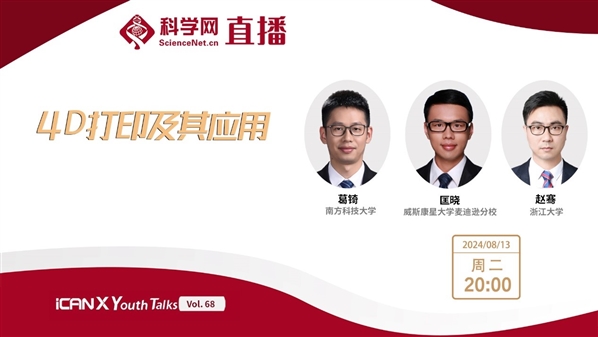
直播时间:2024年8月13日(周二)20:00-22:00
直播平台:

科学网APP
https://weibo.com/l/wblive/p/show/1022:2321325066930787582079
(科学网微博直播间链接)

科学网微博

科学网视频号
北京时间8月13日晚八点,iCANX Youth Talks第六十八期邀请到了南方科技大学葛锜、 威斯康星大学麦迪逊分校匡晓、浙江大学赵骞三位教授主讲,中国科学技术大学孙晓昊、香港科技大学(广州)岳亮、哈尔滨工业大学张风华三位教授担任研讨嘉宾,南方科技大学葛锜教授担任主持人,期待你一起加入这场知识盛宴。
【嘉宾介绍】
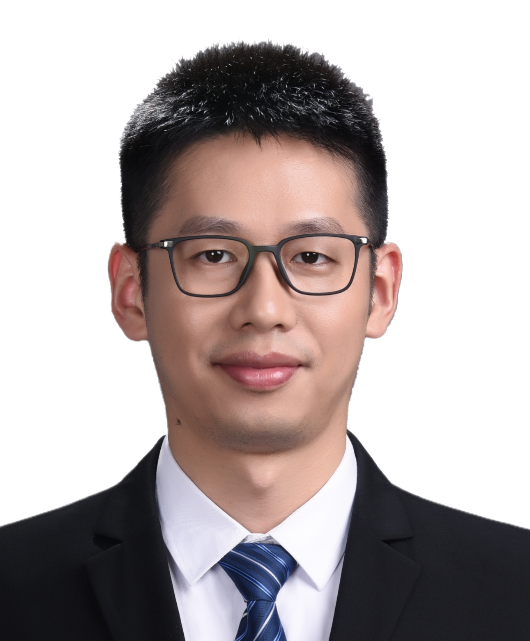
葛锜
南方科技大学
多材料4D打印:从水凝胶到陶瓷
【Abstract】
4D printing is an advanced additive manufacturing technology that print 3D structure with smart materials (i.e. shape memory polymers, hydrogels, liquid crystal elastomers), which makes the 3D printed structures can change shapes, properties, and functionalities over the fourth dimension “time” in response to environmental stimuli such heat, light, electric/magnetic field, moisture, and others. Using the emerging multimaterial 3D printing approaches to print smart materials with other materials (elastomers, hard polymers, conductive polymers or even ceramics) allows us to greatly enrich the performances and functionalities of the 4D printed structures. In this seminar, we will report our recent achievements on multimaterial 4D printing in terms of developments of high-resolution multimaterial 3D printing apparatus, high-performance and photocurable smart materials, and design approaches for multimaterial 4D printing.
4D打印作为一种新型的增材制造技术,通过将智能材料(如形状记忆高分子、水凝胶、液晶弹性等)打印成三维结构,并借助外界环境(热、光、电、磁、湿度等)刺激使得三维结构的形状随着第四个维度时间发生改变。通过多材料3D打印技术将智能材料与其它材料(如弹性体、硬质高分子、导电高分子、甚至陶瓷)打印在一起,可以极大地丰富4D打印结构的性能与功能。在本报告中,我将介绍我们在多材料4D打印方面的新进展:高精度4D打印装备、高性能光固化智能材料,以及面向多材料4D打印的设计方法。
【BIOGRAPHY】
Dr. Qi Ge is a tenured professor at Department of Mechanical and Energy Engineering of Southern University of Science and Technology (SUSTech) and serving as editorial board member of International Journal of Extreme Manufacturing,Microsystems & Nanoengineering. Before Joining SUSTech, he was a Postdoctoral Research Fellow at Massachusetts Institute of Technology, and an Assistant Professor from Singapore University of Technology and Design. Dr. Qi Ge’s research interests include 4D printing and its applications to soft robotics and flexible electronics. He has published more than 100 research papers including the high impact papers published in the top journals such as Science Advances, Nature Communications, Advanced Materials. Among them, 14 papers are ESI highly cited papers. Dr. Ge’s Google Scholar Citation is more than 12000 times, and he is recognized as Elsevier Most Cited Chinese Researcher.
葛锜,博士,南方科技大学机械与能源工程系长聘教授,博士生导师,科研副系主任,深圳市软材料力学与智造重点实验室副主任,International Journal of Extreme Manufacturing,Microsystems & Nanoengineering杂志编委,中国工程物理研究院客座研究员。曾在美国麻省理工学院从事博士后研究,在新加坡科技设计大学担任助理教授。研究领域包括4D打印、智能材料与结构、软体机器人等。累计发表论文100余篇,Google Scholar引用12000余次,H-index 42。以第一或通讯作者在Science Advances (2)、Nature Communications (7)、Advanced Materials(3)等期刊发表多篇高水平论文。入选Elsevier中国高被引学者、斯坦福大学全球前2%顶尖科学家。
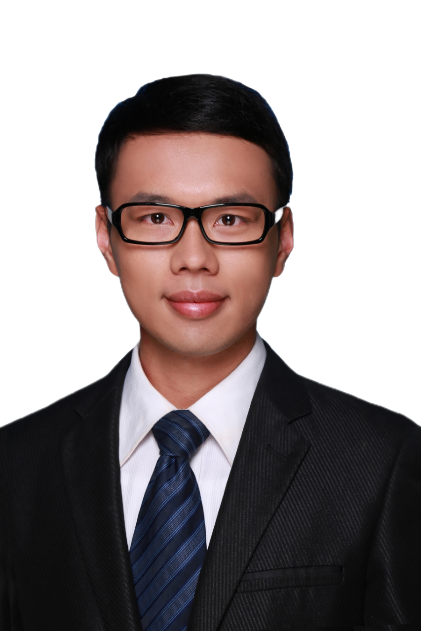
匡晓
威斯康星大学麦迪逊分校
自适应软材料实现体素3D/4D打印
【ABSTRACT】
The landscape of polymer manufacturing has shifted from conventional to advanced techniques, particularly additive manufacturing or 3D printing, finding broad applications in Industry 4.0, aerospace, soft robots, medical devices, and tissue engineering. Light-based 3D printing stands out as the most successful printing modality, utilizing light to selectively solidify polymeric inks layer-by-layer on a build platform. Despite tremendous advancements in 3D printing, the inability to directly manipulate molecular structures and the stringent requirements in ink viscosity and optical properties pose hurdles to material choice and multi-functionality. This talk explores the molecular engineering of polymeric inks and fundamental stimuli-matter interaction understanding to enable voxel-based 3D printing using digital energy, ranging from light to sound. In the first example, photo-thermal dual-cure inks are designed to achieve grayscale digital light processing printing (gDLP). The gDLP can print functionally graded materials with widely tunable stiffness (1 MPa to 1GPa) and high-resolution (~50 μm). We explored applications in 4D printing multiple-shape memory polymers and 3D printing mechanical metamaterials. In the second example, we present a general sonicated ink (or sono-ink) design and focused ultrasound writing technique, collectively to enable deep penetration acoustic volumetric printing (DAVP). Leveraging the unprecedented penetration depth of ultrasound (>100 times than light in scattering medium), we showcase the volumetric printing of opaque (nano)composite constructs without a build platform, even under centimeter-thick soft tissues. We further demonstrate the translation potentials of DAVP in minimally invasive medicine.
聚合物制造的格局从传统技术转向先进技术,特别是增材制造(或3D打印),广泛应用于工业4.0、航空航天、软体机器人、医疗器件和组织工程。基于光的3D打印作为最成功的打印方式,利用光选择性地将聚合物墨水一层层地固化在构建平台上。尽管3D打印取得了巨大的进步,缺少直接操控分子结构的能力和墨水粘度及光学性能的严格要求仍然对材料选择和多功能性构成障碍。本次讲座探讨了利用聚合物墨水的分子工程,并理解刺激-物质相互作用,开发使用数字能量(从光到声)的体素3D打印技术。在第一个例子中,我们设计了光-热两步固化墨水,以实现灰度数字光处理打印技术(gDLP)。我们使用gDLP实现打印具有广泛可调刚度(1 MPa到1 GPa)和高分辨率(~50 μm)的功能梯度材料,并探索了在4D打印多形状记忆聚合物和3D打印力学超材料中的应用。在第二个例子中,我们提出了一种通用的超声波墨水(sono-ink)设计原则和聚焦超声书写技术,共同实现深层穿透的声学体积打印(DAVP)。利用超声波在散射介质中前所未有的穿透深度(超过光的100倍),我们展示了无需构建平台的情况下,打印不透明(纳米)复合材料与结构,甚至在穿透厘米厚的软组织的打印。我们进一步展示了DAVP在微创医学中的临床潜力。
【BIOGRAPHY】
Dr. Kuang Xiao is an incoming Assistant Professor at the University of Wisconsin-Madison in 2024 Fall. Dr. Kuang earned his Ph.D. degree at the University of Chinese Academy of Science in 2016 (Advisor: Professor Dujin Wang). After that, he had his postdoc training at Georgia Institute of Technology (PI: Professor H. Jerry Qi) and Brigham and Women’s Hospital & Harvard Medical School (PI: Professor Yu Shrike Zhang). His research focuses on understanding and developing advanced (de)manufacturing techniques for functional soft materials and (bio)systems, aiming to solve societal challenges in material sustainability and healthcare. Dr. Kuang has published over 80 peer-reviewed papers, including 39 (co)first/corresponding authored papers in journals, including Science, Science Advances, Advanced Materials, Advanced Functional Materials, and Macromolecules (Google citations: >9300, H-index: 46). His research has been highlighted by several federal funding agencies, including NSF, NIH, and AFOSR, and over 100 media outlets. Dr. Kuang serves as a youth editorial board member for Materials and Fundamental Research journals and independent reviews for journals, including Advanced Materials, Nano-micro Letters, Aggregate, Chemical Engineering Journal, ACS. Applied Materials&Interfaces, Additive Manufacturing, Composites: Part B, Polymer, etc.
匡晓博士,2016年毕业于中国科学院大学,获得高分子化学与物理博士学位,导师:王笃金教授;2016-2020年于佐治亚理工学院机械工程系做博士后,合作导师:齐航教授;2020-2024年,在莱根妇女医院和哈佛医学院继续开展博士后研究,合作导师:张宇教授;并将于2024年秋季担任助理教授,入职威斯康星大学-麦迪逊分校的机械工程系。匡博士主要开展功能性软材料和(生物)系统及其先进制造技术的研究,旨在解决材料可持续性和医疗保健方面的社会挑战。匡博士目前已发表80多篇论文,包括39篇 (共同)第一/通讯作者文章发表在Science, Science Advances, Advanced Materials, Advanced Functional Materials, 和 Macromolecules(总引用次数:>9300,H指数:46);申请9项专利,并合著7本书章节。其研究进展受到NSF、NIH和AFOSR在内的多个联邦资助机构的关注,并在100多家媒体上进行了报道。匡博士担任Materials和Fundamental Research期刊青年编委;作为Advanced Materials、Nano-micro Letters、Aggregate、Chemical Engineering Journal、ACS. Applied Materials&Interfaces、Additive Manufacturing、Composites: Part B和 Polymer在内的多个期刊的审稿人。
赵骞
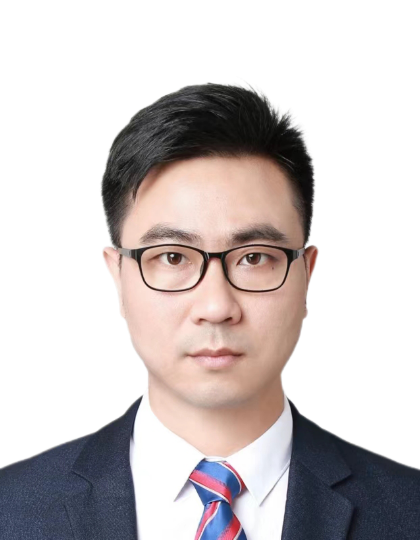
浙江大学
可4D打印的定时变形形状记忆水凝胶
【ABSTRACT】
Shape memory polymers (SMPs) are typical materials for 4D printing, which can recover from pre-defined temporary shape to the original shape upon external stimuli. They have shown great potential in deformable and transplantable medical devices for minimally invasive surgery. However, traditional SMPs commonly present instantaneous responses to the stimuli, which leads to uncontrollable deformation and limited manipulation time window. To address this problem, this talk introduces a brand-new shape recovery mode. Instead of the instantaneous shapeshifting, the shape of the materials keeps stable during a certain incubation period before the shape recovery begins based on a spinodal decomposition mechanism. In this system, the phase reconfiguration dominates the shape transformation instead of the thermal diffusion for conventional SMPs. Thus, the starting time of the shape recovery can be decoupled with the triggering of stimuli. The construction of material systems and the manipulation methods for the incubated period were investigated. On top of this, 4D printing was used to fabricate incubated SMP devices with complex geometries for prototyping of biomedical evaluations, including anal fistula embolism, lacrimal duct embolism, and abdominal fluid drainage.
形状记忆聚合物(SMPs)是可实现4D打印的常用材料,可在外界环境条件变化时由预设的临时形状回复到原始形状,有望用做可变形植入医疗器件,以到达微创与降低手术难度的效果。然而,传统SMPs变形与刺激耦合,即刺激施加后立刻发生响应性变形,导致器件展开时卡在非目标位置,使植入失败。针对植入时间窗口短且变形不可控的问题,本研究提出定时形状记忆变形新模式,即材料在受到刺激后不会立刻发生变形,而是存在可保持形状稳定的潜伏期,随后才发生形状回复,从而使植入过程更可控。这种模式使材料的变形不依赖于刺激控制,可按需自发进行。本研究利用热致相分离水凝胶相态演变的动力学过程实现该变形模式,并研究了其分子机制与潜伏期的调控方法。之后,研究利用光固化4D打印,针对三种实际场景包括肛瘘栓塞、泪道栓塞、腹腔积液引流设计制备了相应的医用定时变形器件。器件可以硬质状态保持临时形状植入或穿刺,在一定的操作时间后精准定位至病灶,展示了进一步临床应用的可行性与独特性。
【BIOGRAPHY】
Dr. Qian Zhao received his PhD degree in chemical engineering from Zhejiang University in China (2009). During the following four years he worked for Zhejiang University and afterwards for Helmholtz-Zentrum Geesthacht (HZG) in Teltow, Germany with Professor Andreas Lendlein as a postdoctoral researcher. He became a faculty member of College of Chemical and Biological Engineering, Zhejiang University in 2013, and had been promoted to Associate Professor in 2015 and Professor in 2020. His current research interests focus on shape changing polymers especially shape-memory polymers, stimuli-responsive hydrogels, and four-dimensional printing. He has published more than 100 papers in prestige journals including Nature, Sci. Adv., Nat. Commun., Adv. Mater, etc.
赵骞,2004年与2009年于浙江大学分别获得学士与博士学位;2009-2011年在浙江大学化工学院从事博士后研究;2011-2013年于德国亥姆霍兹国家研究中心继续博士后研究;2013年任浙江大学化工学院讲师,2016年晋升为副教授,2021年晋升为教授。2016年获中国新锐科技人物突出贡献奖。主要从事受激形变高分子及其3D/4D打印研究。在Nature, Nature Communications, Science Advances, Advanced Materials等期刊上发表100余篇。
【主持人】

葛锜
南方科技大学
【研讨嘉宾】
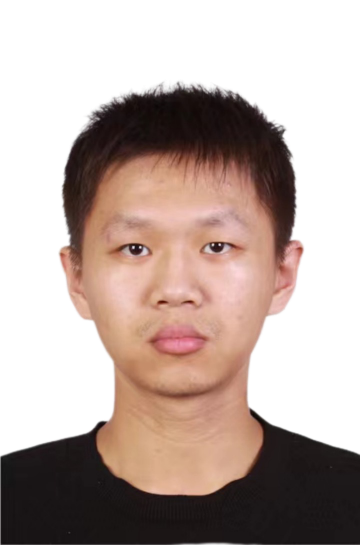
孙晓昊
中国科学技术大学
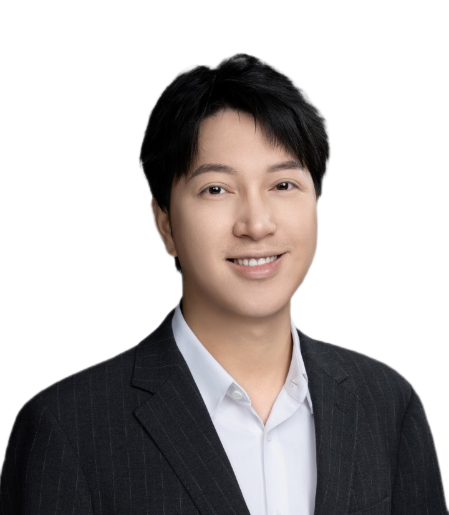
岳亮
香港科技大学(广州)
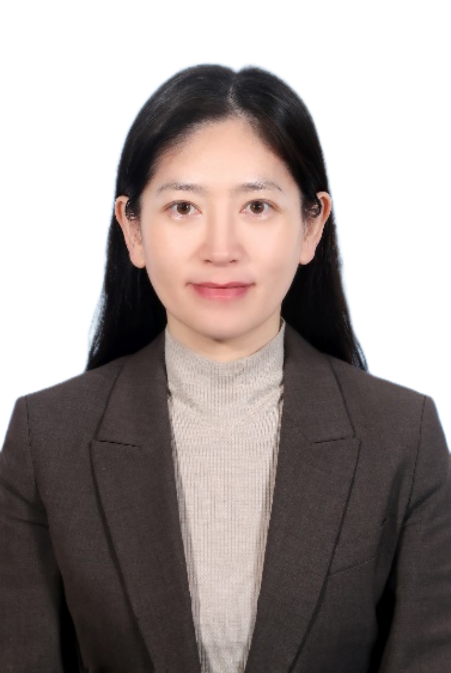
张风华
哈尔滨工业大学
特别声明:本文转载仅仅是出于传播信息的需要,并不意味着代表本网站观点或证实其内容的真实性;如其他媒体、网站或个人从本网站转载使用,须保留本网站注明的“来源”,并自负版权等法律责任;作者如果不希望被转载或者联系转载稿费等事宜,请与我们接洽。